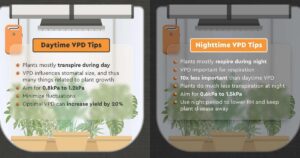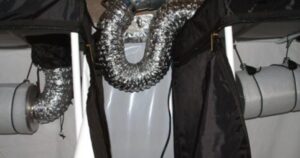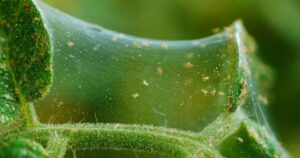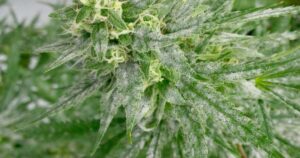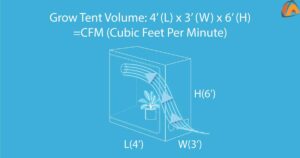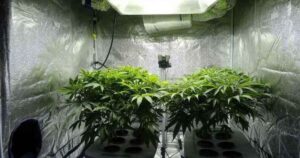If you’re venturing into indoor gardening with a grow tent, understanding CFM (Cubic Feet per Minute) is crucial. CFM for grow tents refers to the measurement of airflow needed to maintain optimal conditions for plant growth within the enclosed space. It essentially quantifies how much air should be exchanged every minute to ensure proper ventilation and environmental control inside the grow tent.
Wondering How To Calculate CFM For Grow Tent? It’s not just a technicality; it’s the key to unlocking a thriving indoor garden. In the upcoming paragraphs, we’ll guide you through the simple steps to calculate CFM, empowering you to create the ideal environment for your plants.
Now, let’s delve into the specifics of CFM For Grow Tent. Ensuring the right airflow is essential for temperature regulation, humidity control, and preventing the buildup of stale air. This article breaks down the process of calculating CFM into easy-to-follow steps, empowering both beginners and seasoned growers.
Key Factors in Calculating CFM for Grow Tents
When setting up a grow tent, understanding the key factors in calculating Cubic Feet per Minute (CFM) is crucial for creating an optimal environment for your plants. Here is a simple table can help organize these factors, allowing you to easily calculate the necessary CFM for your grow tent setup.
| Factors | Description |
|---|---|
| Tent Size | Consider the length, width, and height of your grow tent to determine the required airflow. |
| Equipment Heat | Factor in the heat generated by lights, fans, and other equipment to maintain a suitable temperature. |
| Air Exchange Rate | Decide on the frequency of air changes within the tent, usually measured in minutes per exchange. |
| Total CFM Calculation | Calculate the total CFM needed by combining the effects of tent size, equipment heat, and air exchange rate. |
Optimal Air Exchange Rates for Indoor Cultivation
Determining Ventilation Requirements Based on Grow Space Size

The key to a successful indoor garden lies in understanding and implementing the right ventilation system, tailored to the size of your grow space. In the quest for optimal plant growth, determining ventilation requirements becomes crucial. The size of your grow space directly influences the amount of fresh air needed to maintain a healthy environment for your plants. It’s like giving your plants a breath of fresh air, quite literally.
Imagine your grow space as a unique ecosystem, and the ventilation system as its respiratory system. To simplify, the larger the space, the more air circulation is required. By establishing an efficient, you ensure a constant exchange of carbon dioxide and oxygen, promoting robust plant development. Consider the dimensions of your grow space as a guide to determining the appropriate ventilation setup for a flourishing indoor garden.
Importance of Temperature and Humidity Control in CFM Calculation
The significance of maintaining precise temperature and humidity levels in the calculation of cubic feet per minute (CFM) cannot be overstated. Achieving optimal conditions in a space is crucial for various reasons, ranging from energy efficiency to human comfort and well-being.
When it comes to CFM calculations, temperature and humidity play pivotal roles in determining airflow rates, affecting the overall efficiency of ventilation and air conditioning systems. In simpler terms, controlling these factors ensures that the air in a room circulates effectively and provides a comfortable environment.
In addition to energy conservation, maintaining the right temperature and humidity levels contributes to equipment longevity and prevents issues like condensation and mold growth. Proper control of these variables not only enhances indoor air quality but also positively impacts overall health and productivity.
Selecting the Right Inline Fan for Efficient Airflow

Choosing the perfect inline fan is crucial for maintaining optimal airflow in your space. The right fan can make a significant difference in ventilation efficiency, ensuring a fresh and comfortable environment. Consider factors such as fan size, airflow capacity, and noise levels to tailor your choice to your specific needs.
A larger space may require a fan with higher airflow capacity, while noise considerations become more critical in residential settings. It’s also essential to think about energy efficiency to keep operational costs in check. To simplify the decision-making process, you can create a comparison table with key features and specifications of different inline fans, including dimensions, airflow rates, noise levels, and energy consumption.
Fine-Tuning CFM: Considerations for Grow Light and Plant Density
In the quest for cultivating healthier plants, achieving an optimal balance in Controlled Environment Agriculture (CEA) is crucial. Choosing the right grow lights ensures that plants receive the right spectrum and intensity, promoting robust growth. Additionally, striking the ideal plant density is equally vital, as it influences nutrient absorption and overall plant health. To simplify this, consider the following key points:
- Lighting Considerations:
- Select lights with the appropriate spectrum for different growth stages.
- Adjust light intensity based on the specific needs of the plants.
- Plant Density Factors:
- Find the optimal spacing to avoid overcrowding or underutilization of space.
- Consider the species and growth habits of plants when determining density.
By addressing these considerations, growers can fine-tune their Controlled Environment Farming (CFM) setups, fostering an environment where plants thrive and yield abundantly.
FAQs
How many CFM do I need for my grow room?
The recommended CFM for a grow room is 1 to 2 times the room volume per minute.
What is the CFM formula?
CFM (Cubic Feet per Minute) is calculated by multiplying the room’s length, width, and height, and then multiplying the result by the air exchange rate desired.
Conclusion
Understanding how to calculate CFM (cubic feet per minute) for a grow tent is essential for maintaining an optimal environment for plant growth. By considering factors such as tent size, ventilation equipment, and the specific needs of the plants, growers can ensure proper air exchange, temperature control, and humidity regulation. Achieving the right CFM helps create a healthy and productive growing environment, ultimately contributing to successful cultivation outcomes.

